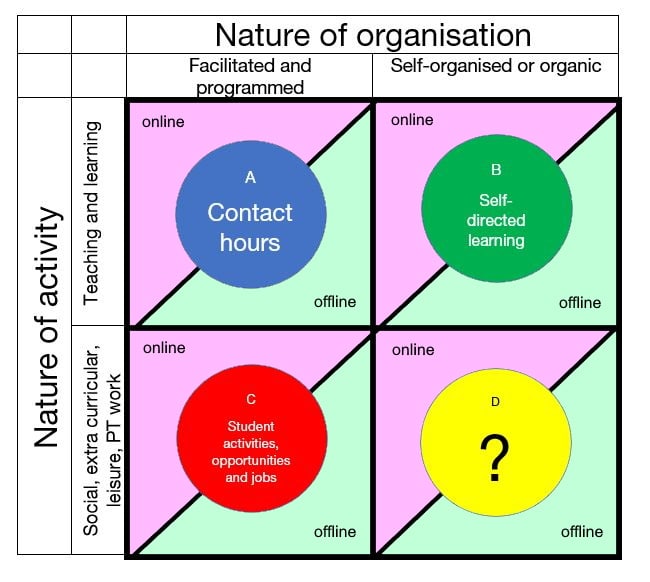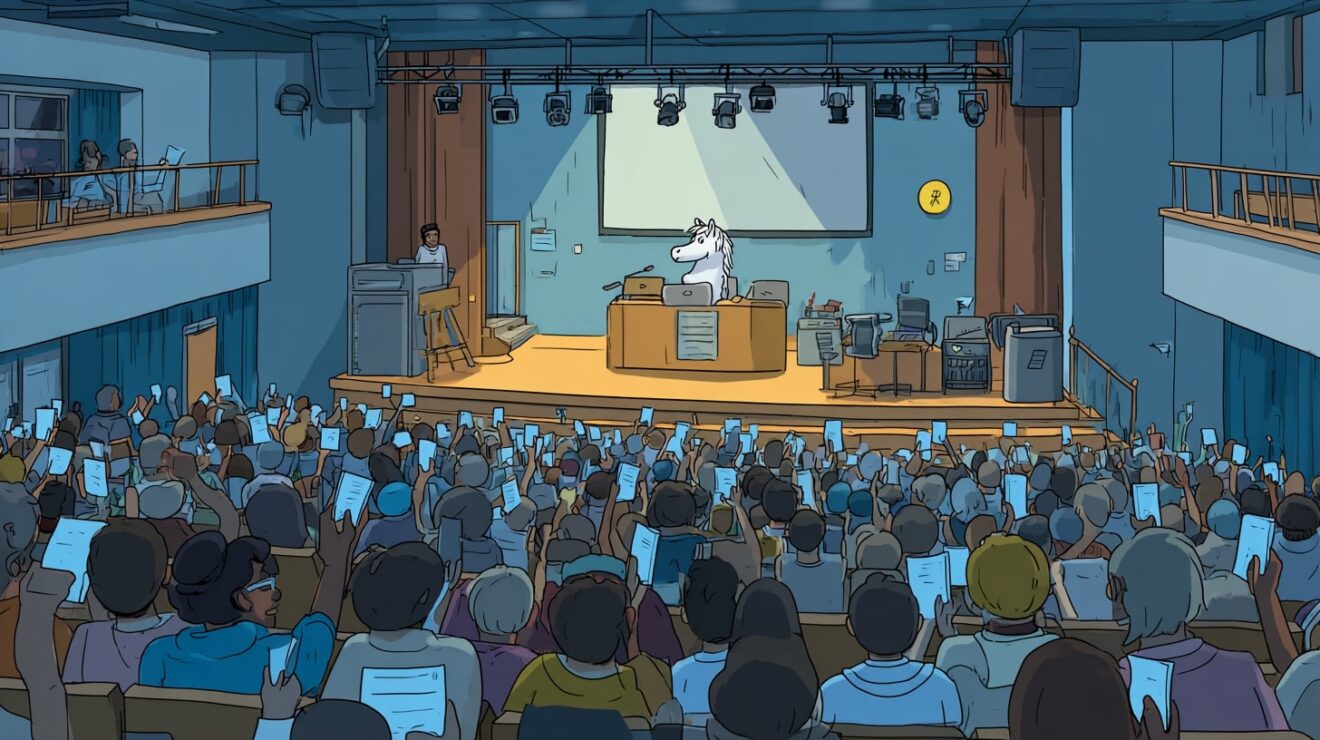At various points during the pandemic I’ve been writing about and talking to institutions and their SUs about the student experience.
You know the sort of thing – the ways in which the student experience has and will be been affected, the sorts of things people are planning for September and the kinds of expectations that students might have in terms of various aspects of it.
For example – I keep worrying about whether anyone got any sense of what we are assuming or expecting students to do all week? They can’t be on campus. They’ll be discouraged from mixing. The teaching and social activity won’t amount to many hours. There won’t be room in libraries or cafes. So what do they… Do?
In fact (much) more importantly, let’s think not through an activity lens but through a location lens. Where do we think or want them to be all week? The park? WH Smiths? A tent? Their tiny room?
And given we are putting E&D issues front and centre – if you’re a student already marginalised and you’re discouraged from mixing – how do you see or find others like you?
Plenty of universities are thinking about codes of behaviour and rules that are trying to stop students doing something – but shouldn’t we have some idea of what it is we think they’ll be doing with their days and nights instead?
A model
So to try to get my thoughts in some order, I’ve been playing with a little model that I thought I would share in case it’s useful for others.
As you can see I identify three “either-or”s in the model:
- The first differentiates between what I would call “teaching and learning” activity and wider social or extra-curricular activity;
- The second between that which is timetabled, programmed and formally facilitated and that which just organically “happens”;
- The third of which (the diagonal line splits) is whether activities are envisaged to be, likely to be or even possible to be offline or online next year.

A few things to say about it…
Contact time
So far in institutional planning, lots of attention has been paid to Box A. But in volume/hours terms, that Box A stuff is not a huge part of an average student’s week. It’s important – but doesn’t use up much time.
Clearly the “balance of hours” between A, B C and D varies significantly between courses, students, universities, students and circumstances. But we can play and make some assumptions – not least that (for example) there is a theoretical “number” involved in A+B in a given week of higher education delivery for a particular student on a taught programme during term time to “achieve” the learning objectives.
Although there are plenty of differences, the HEPI/Advance HE Student Academic Experience Survey 2020 tells us that the average formal “contact” hours for a student (ia Box A) are 14.6, with 14.1 hours of independent study (Box B). It’s therefore worth saying that if campus space is prioritised for activities in Box A, where a student on a particular course or at a particular stage has much more of their week in Box B than Box A, we may be at risk of them hardly being allowed on campus to see other students at all.
The A game
Sticking with “Box A” for a minute. In most universities the teaching that doesn’t require much interaction has already been put online, so what’s left for “in person” or “face to face” delivery is teaching that involves the back and forth, the Q&A, and the group work. But where this is “in person”, students are sat miles away from each other, and miles away from their academics. Everyone struggles to hear and understand everyone else.
Most of the time some students will be late because of public transport restrictions, and every week there could be any number of other students missing altogether because they’re having to self isolate for a fortnight. Some that were immunocompromised will have already been told to stay away – not healthy enough to make the F2F cut, despite assurances on “equality first”.
Some academics, worried about catching the virus, won’t be back on campus all term and are trying, from home, to facilitate interaction between 15 students sat miles apart in a sports hall. Others won’t come in for the same reason that some students can’t. Someone suggests that those joining remotely but synchronously should be able to take part – but if you’re “teaching”, do you focus on Zoom, or the room, or both? And how do each of those groups interact with each other?
Right now universities are spending millions converting “audio only” teaching spaces to capture video too. But because what is left is the interactive bit, we need multiple microphones in each room, and these too cost a fortune. But if in every hour of “Box A” contact there will be more students trying to access the teaching online than in person, will the millions be enough? What if it turns out that however hard we try, we can’t really make “Box A” activity work “in person”?
The other thing to note is that running activity either online or offline has different considerations in any of the four boxes – but it seems unlikely that it will be possible to run activity in any of those boxes online and offline simultaneously.
Independent study
Much “Box B” independent study happens on campuses – sometimes with use of specialist books and equipment or in libraries or in labs or studios or booked rooms – and often happens in groups. We noted here that a lot of on-campus facilities are ways to “level up” and ensure students without space or digital equipment can access learning. Again, if space and facilities on campus have been heavily rationed in favour of “Box A”, a good question to ask is where – and how – will students complete their “Box B” independent study hours?
There are wider debates about offline v online in Box A – which is all effectively “synchronous” which we mentioned in here. As noted, the TL;DR on synchronous v asynchronous (ie moving some activity/hours from Box A to Box B) is that from a “learning gain” point of view, asynchronous edges it – but this is different for different students, has to be high quality (not “here’s an hour’s worth of reading”), has to be appropriate for the learning objectives and it does worse on (surprise surprise) community/belonging and student perceptions of “value” (this is the same theory that says that people “value” PDFs more than word documents even if the content is identical).
Social isn’t optional
Some other thoughts. Very few people are thinking about “Box D” but it’s absolutely vital. Will there be campus facilities for this – not least because our usual facilities (going to pubs, clubs, cafes and each other’s houses) are likely to be severely restricted?
For so many students what happens in Box C and D is essential for mental health, wellbeing and wider social and educational development. But activity in Box D is really hard to make happen organically online – insofar as it tends to happen between people who met via Box A or C. So arguably we should assume that we need to do much more “Box C” than “Box D” than usual to engender belonging between students.
Lots of universities have done some limited and shallow thinking about “Box C”, but mainly for new students and mainly re September. But arguably there needs to be indoor space (December will be coooold) for “Box C” right from the start, and booked for the whole term. What if “teaching” has used it all up?
Using the model
One way of using the model is to take a student – either by course or by characteristic – and have a think about the hours in each of the eight half squares and the activities in each of them – and then to think about the potential implications.
For example, so much of all four has already moved online in recent years, and is arguably quite an unhealthy experience as a result already. Are we about to make that all worse – especially if all but (say) 6 hours on this grid are to be spent staring at a screen?
The other way to use it would be to imagine what life will be like overall for a student by course or by characteristic, and to think about three things:
- What are the expectations being generated right now by the comms and marketing – and how will they differ to the potential reality?
- What level of responsibility do we have as a university or SU over each of the four areas – especially given the way the holistic “experience” is marketed.
- There are major risks inherent in the balance of hours between all eight areas and in lots of the activity in the four Boxes moving to “online”. How are we regulating – to both avoid the risks from crystallising, and changing practice to ensure we know what to do if they do crystallise?
You might have other thoughts and/or uses for the model. For example, one academic writes:
Based on a student engagement/experience event with c. 30 student reps from different institutions/disciplines, ‘C’ is by far the biggest factor. ‘A’ & ‘B’ only appeared after we’d filled the whole ‘Experience Map’ with ‘C’! It was a light-bulb moment for the academics attending”
If you also have thoughts, comments or uses – please do let us know in the comments below.


















